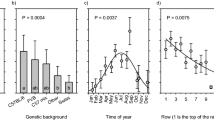Summary
Adult, male white-footed mice (Peromyscus leucopus) were subjected to a variety of social situations ranging from isolation during the 20 day experimental period to constant contact with both females and other adult males. Contacts included grouping (three or four males per cage) and exposure to fighters (once daily for 20 minutes). The following measurements were recorded: weights of the body, testes, epididymides, vesicular glands, vesicular gland tissue (wet and dry), seminal fluid of the vesicular gland, adrenal glands, and baculum; spermatozoan reserves of the testes and epididymides. Grouping significantly affected both the weight and spermatozoan reserves of the testes and epididymides, as well as both the tissue and seminal fluid weight of the vesicular glands. The results suggested a graded effect of all treatments on the reproductive tract. In order of magnitude of the associated response, from none to greatest, the treatments may be ranked as follows: pairing with females, isolating, handling, fighting, and grouping. All reproductive parameters measured showed this general ranking, suggesting that the response to the various treatments was similar and differed only quantitatively. The results further suggested decreased secretion of LH and testosterone, although measurements of testosterone did not substantiate this conclusion. The lack of significant effects of grouping on adrenal gland weights strengthened the argument that adrenal involvement is not a necessary adjunct to the suppression of the reproductive tract in groupedPeromyscus, but the adrenal may be involved if contacts between males result in overt fighting.
Similar content being viewed by others
References
Amann, R. P. (1970) Sperm production rates. Pages 433–482inA. D.Johnson, W. R.Gomes andN. L.Vandemark, eds.The testis: Vol. I.Development, anatomy andphysiology. Academic Press, New York. 684 pp.
Amann, R. P. andJ. O. Almquist (1961) Reproductive capacity of dairy bulls. I. Technique for direct measurement of gonadal and extra-gonadal sperm reserves.J. Dairy Sci.44: 1537–1543.
Amann, R. P. andJ. T. Lambiase (1969) The male rabbit. III. Determination of daily sperm production by means of testicular homogenates.J. Anim. Sci.28: 369–374.
Bronson, F. H. andB. E. Eleftheriou (1963) Adrenal responses to crowding inPeromyscus and C57BL/10J mice.Physiol. Zool.36: 161–166.
Bronson, F. H. andB. E. Eleftheriou (1964) Chronic physiological effects of fighting in mice.Gen. Comp. Endocrinol.4: 9–14.
Brown, R. Z. (1953) Social behavior, reproduction and population changes in the house mouse (Mus musculus L.).Ecol. Monogr.23: 217–240.
Christian, J. J. (1959) Adrenocortical, splenic, and reproductive responses to inanition and grouping.Endocrinology65: 189–197.
Christian, J. J. (1971a) Population density and reproductive efficiency.Biol. Reprod.4: 248–294.
Christian, J. J. (1971b) Population density and fertility in mammals. Pages 471–499inP. P.Foa, ed.The actions of hormones: genes to population. Charles Thomas, Springfield, Ill. 547 pp.
Christian, J. J. andD. E. Davis (1964) Endocrines, behavior and population.Science146: 1550–1560.
Christian, J. J., J. A. Lloyd andD. E. Davis (1965) The role of endocrines in the self-regulation of mammalian populations.Recent Prog. Horm. Res.21: 501–578.
Clarke, J. R. (1953) The effects of fighting on the adrenals, thymus, and spleen of the vole (Microtus agrestis).J. Endocrinol.9: 114–126.
Clermont, Y. andH. Morgentaler (1955) Quantitative study of spermatogenesis in the hypophysectomized rat.Endocrinology57: 369–382.
Courot, M., M. T. Hochereau-de Reviers andR. Ortavant (1970) Spermatogenesis. Pages 339–432inA. D.Johnson, W. R.Gomes, andN. L.Vandemark, eds.The testis: Vol. I.Development, anatomy and physiology. Academic Press, New York. 684 pp.
Eleftheriou, B. E. andR. L. Church (1967) Effects of repeated exposure to aggression and defeat on plasma and pituitary leves of luteinizing hormone in C57BL/6J mice.Gen. Comp. Endocrinol.9: 163–266.
Lloyd, J. A. (1971) Weights of testes, thymi and accessory reproductive glands in relation to rank in paired and grouped house mice (Mus musculus).Proc. Soc. Exp. Biol. and Med.137: 19–22.
McKinney, T. D. andJ. N. Pasley (1973) Effects of social rank and social disruption in adult male house mice.Gen. Comp. Endocrinol.20: 579–583.
Scott, J. P. (1946) Incomplete adjustment caused by frustration of untrained fighting mice.J. Comp. Psychol.39: 379–390.
Southwick, C. H. (1955) The population dynamics of confined house mice supplied with unlimited food.Ecology36: 212–225.
Terman, C. R. (1965) A study of population growth and control exhibited in the laboratory by prairie deermice.Ecology46: 890–895.
Terman, C. R. (1966) Population fluctuation ofPeromyscus maniculatus and other small mammals as revealed by the North American Census of Small Mammals.Amer. Midland Nat.76: 419–426.
Terman, C. R. (1969) Weights of selected organs of deermice (Peromyscus maniculatus bairdii) from asymptotic laboratory populations.J. Mammal.50: 311–320.
Author information
Authors and Affiliations
Rights and permissions
About this article
Cite this article
Sullivan, J.A., Scanlon, P.F. Effects of grouping and fighting on the reproductive tracts of male white-footed mice (Peromyscus leucopus). Res Popul Ecol 17, 164–175 (1976). https://doi.org/10.1007/BF02530768
Issue Date:
DOI: https://doi.org/10.1007/BF02530768




